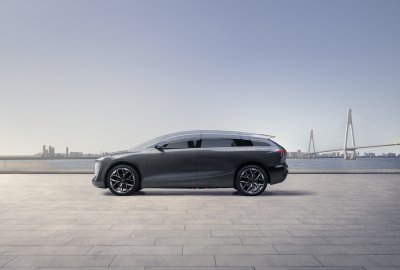Audi has revealed the third in a series of concept cars dedicated to the future of mobility, this time with a focus on urban transportation in China.
The Audi Urbansphere concept was built with the country’s traffic-clogged megacities, envisioning a future where the vehicle can fill the void of providing personal space where it’s lacking. This is the third concept of “sphere”. The company showed off its Skysphere and Grandsphere concepts last year.
In a press release, Audi Chairman Markus Duesmann said engineers and designers built a pickup truck to exemplify the needs of its Chinese customer base.
“To make electric mobility even more attractive, we think about it holistically and starting from customer needs,” said Duesmann. “More than ever, it is not just the product that is decisive, but the entire ecosystem. That is why Audi is creating a comprehensive ecosystem with services for the entire car. The Audi urbansphere concept also offers everyone on board a wide range of options. … use that freedom to provide a highly personalized in-car experience: communication or relaxation, work or retreat to a private sphere as desired.”
one of 18

Audi AG
On the outside, the Urbansphere takes the form of a futuristic minivan. A black grille with a hexagonal pattern occupies most of the front, while lines along the sides trend upwards. The sloped tail of the roof adds to the aerodynamic efficiency of the car.
Robby Degraff, an analyst at AutoPacific, told Newsweek that grills are becoming a canvas for automakers as electric vehicles become more popular, saying the “pixelated” grille design of the car is likely Urbansphere see the production.
“By not needing as much open functional space for cooling as a [internal combustion engine] vehicle, automakers really do have a blank canvas and opportunity to play around and modify the front faces of electric vehicles, adding unique textures that even include clean creative integration of daytime running lights, turn signals, etc,” he said. .
Making a van for the Chinese market is also a smart move. While the segment is known for family-focused vehicles in the US, it’s a different story in Asia.
one of 9

Audi AG
“Markets like China, Korea and Japan are full of sumptuous, dazzling, tech-packed vans that often do their duty transporting executives and other VIPs,” he explained. “That seems to be the intention that Audi is going for here with this concept, dividing the task of designing the Urbansphere directly with its team in Beijing.”
A production version of Urbansphere for the Asian market is likely to come out in the next few years.
Powering the concept is a 120-kilowatt-hour battery and two electric motors. That torque works out to produce around 295 horsepower and 508 pound-feet of torque.
The company estimates that the car has a range of 466 miles. Using an 800-volt architecture, Audi says the car can charge from 5 to 85 percent in less than 25 minutes.
Audi says its adaptive air suspension with semi-active damper control makes for a smooth ride, whether on bumpy downtown streets or smooth motorways.
In each of the dial concepts, Audi has paid close attention to the interior. There is no B-pillar on the car, as the doors are opposite-hinged. When the doors open, a red carpet is projected on the floor.
Rotating seats allow passengers to turn and face each other to talk. In contrast, a headrest privacy screen can provide a passenger with privacy from the person sitting next to them.
Degraff points out that as automakers introduce concepts to convert cabins into living spaces or lounges, many of those ideas will be incorporated into production models of electric vehicles. Doing so gives passengers a comforting space during loading times.
“We’re still years away from charging times that take as little as five minutes as it would at a gas pump, so the cabin of an electric vehicle needs to be a space that allows the seatback to recline and unfold a center console to read a book or prop up a laptop and wait comfortably without having to get out of the vehicle,” he said.
The surfaces are covered with wood, wool and synthetic fabrics.
At the front, the screens are projected instead of a traditional board. The settings on those screens change depending on the driving mode. Drivers and passengers can control and make adjustments to these screens with a combination of eye tracking, hand gestures and touch controls.
Some surfaces at the front and rear can be illuminated in different colours, which can be adapted to traffic situations, the surroundings or the mood of the passengers.
Audi says the truck was designed around the idea of future autonomous technology, which would eliminate the need for a steering wheel or pedals.
